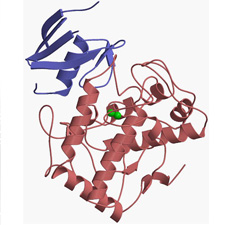







Tyrosinase enzyme
Tyrosinase (also known as monophenol monooxygenase) is a copper-containing enzyme with a chemical role of catalysing the ortho-hydroxylation of monophenols into ortho-diphenols or, alternatively, the oxidation of ortho-diphenols into the corresponding ortho-quinones. In humans, the tyrosinase enzyme is encoded by the TYR gene. It catalyzes the first two steps in mammalian melanogenesis and is responsible for enzymatic browning reactions in damaged fruits during post-harvest handling and processing.
In the formation of melanin pigments, three types of tyrosinase are involved with different binuclear copper structures of the active site. Oxytyrosinase, mettyrosinase and deoxytyrosinase.
Usually, Tyrosinase Inhibitors are classified into four types, including competitive inhibitors, uncompetitive inhibitors, mixed type (competitive/uncompetitive) inhibitors, and non-competitive inhibitors
- Competitive Tyrosinase Inhibitors. A competitive inhibitor is a substance that combines with a free enzyme in a manner that prevents substrate binding. That is, the inhibitor and the substrate are mutually exclusive, often because of true competition for the same site. A competitive inhibitor might be a copper chelator, non-metabolizable analogs, or derivatives of the true substrate.
- Uncompetitive Tyrosinase Inhibitors. In contrast, an uncompetitive inhibitor can bind only to the enzyme-substrate complex. A mixed (competitive and uncompetitive mixed) type inhibitor can bind not only with a free enzyme but also with the enzyme-substrate complex.
- Mixed Tyrosinase Inhibitors. A mixed (competitive and uncompetitive mixed) type inhibitor can bind not only with a free enzyme but also with the enzyme-substrate complex. For most mixed-type inhibitors, their equilibrium binding constants for the free enzyme and the enzyme-substrate complex, respectively, are different.
- Non-Competitive Tyrosinase Inhibitors. A special case among the mixed inhibitors is the non-competitive inhibitors, which bind to a free enzyme and an enzyme-substrate complex with the same equilibrium constant.
>
>
>
>
>
>
>
>
>
>
>
>
>
>
>
>
>
>
>
>
>
TYROSINASE INHIBITORS
Polyphenols
Benzaldehyde and Benzoate Derivatives
Gallic Acid and Derivatives
Long-Chain Lipids and Steroids
INHIBITORS OF MELANOSOMAL TRANSFER
Centaureidin and Methylophiopogonanone B
Niacinamide
PAR-2 Inhibitors
Lectins and Neoglycoproteins
ANTIOXIDANTS
Glutathione
Vitamin C
Alpha Tocopherol and Alpha Tocopherol Ferulate
ACCELERATORS OF EPIDERMAL TURNOVER AND DESQUAMATORS
α-Hydroxyacids
Salicylic Acid
Linoleic Acid
Retinoids
TRANSCRIPTIONAL REGULATION OF MELANOGENIC ENZYMES
The MAPK Pathway
MC1R
cAMP Pathway and MITF

Next: Polyphenols >>